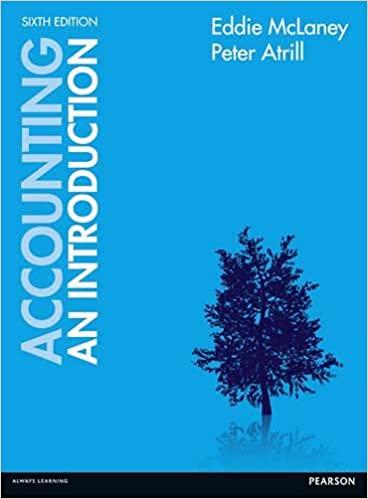5) 5) Use the following information for Meeker Corp. to determine the amount of equity to report. $ Cash Buildings Land Liabilities 70,000 125,000 205,000 130,000 A) $270,000. B) $140,000. C) $20,000. D) $390,000 E) $530,000 6) Decreases in equity from costs of providing products or services to customers are called: A) Equity B) Expenses. C) Liabilities. D) Stockholders' Investment. E) Withdrawals. 7) 7) On December 15 of the current year, Conrad Accounting Services signed a $40,000 contract with a client to provide bookkeeping services to the client in the following year. Which accounting principle would require Conrad Accounting Services to record the bookkeeping revenue in the following year and not the year the cash was received? A) Monetary unit assumption. B) Business entity assumption. C) Going-concern assumption. D) Measurement (Cost) principle. E) Revenue recognition principle. 8) If assets are $99,000 and liabilities are $32,000, then equity equals: A) 599,000 B) S131,000 C) $198.000. D) $32,000. E) S67.000. 9) 9) Flitter reported net income of $17.500 for the past year. At the beginning of the year the company had $200,000 in assets and $50,000 in liabilities. By the end of the year, assets had increased to $300,000 and liabilities were $75,000. Calculate its return on assets: A) 7.0%. B) 8.8%. C) 23.3% D) 35.0% E) 5.8%. 10) 10) Which of the following accounts is not included in the liability section of the balance sheet? A) Notes payable. B) Taxes payable C) Accounts receivable. D) Accounts payable E) Wages payable. 1) 11) Identify the correct formula below used to calculate the debt ratio. A) Total Equity/Total Liabilities. B) Total Assets/Total Liabilities. C) Total Liabilities/Total Assets. D) Total Liabilities/Total Equity. E) Total Equity/Total Assets. 12) 12) A credit entry: A) Decreases asset and expense accounts, and increases liability, common stock, and revenue accounts. B) Increases asset and expense accounts, and decreases liability, common stock, and revenue accounts C) Is recorded on the left side of a T-account. D) Always increases an account, E) Always decreases an account. 13) A debit is used to record which of the following: A) A decrease in an asset account. B) An increase in the dividends account. C) A decrease in an expense account. D) An increase in the common stock account. E) An increase in a revenue account








